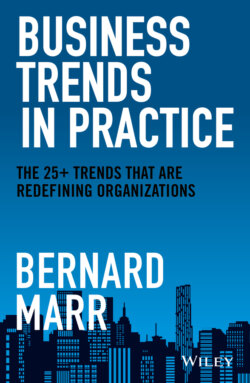Читать книгу Business Trends in Practice - Бернард Марр, Bernard Marr - Страница 13
Trend 4: Shifting Demographics
ОглавлениеThe global population in 2050, or even 2030, will look very different from today. Depending on where you are in the world, the population is growing and aging. We're seeing greater urbanization and more megacities. And, as I've previously mentioned, climate change may mean hundreds of millions of people are displaced and forced to migrate to other areas.
Let's get a quick overview of how the population is changing:
According to a UN forecast, the world's population was expected to increase by 2 billion in the next 30 years, from 7.7 billion in 2020 to 9.7 billion in 2050.16
However, recent estimates suggest the population may peak sooner than that, at 9.7 billion in 2064, and then decline to 8.8 billion by the end of the century.17 In other words, it looks as though population growth is slowing, not least because more and more women can now choose to have fewer children.
While the total global population is still growing, some countries are witnessing population decline due to factors such as migration and low birthrates. For example, Russia's population is expected to shrink by 18 million between 2006 and 2030, and Japan's population is projected to decrease by 11 million.18
What's more, the world's population is growing older. As an example, in 1950, life expectancy in China was 40 years. By 2050, it will be 80 years.19 This pattern is replicated across the world. In 2006, there were almost 500 million people in the world aged 65 and older. By 2030, that is projected to increase to 1 billion people, or 1 in 8 of the world's inhabitants.20 This is good news because it shows that we have improved healthcare and living standards to allow people to live longer, but it does create societal and economic pressures.
People are on the move, too. The number of people living in urban areas is rising rapidly. The world's urban population grew from 751 million in 1950 to 4.2 billion in 2018. Currently, 55 percent of the global population lives in urban areas, and this will increase to 68 percent by 2050. Asia is home to 54 percent of the world's urban population.21
The number of megacities (classified by the UN as cities with 10 million or more inhabitants) is also on the rise. By 2030, there will be 43 megacities, up from 33 in 2018.22
The cities that we live in will increasingly become “smart” and connected. There will be more than 25 global smart cities in 2025 (more than 50 percent of which will be in Europe and North America).23
Meanwhile, the shift to more urban living will drive huge economic growth in developing economies. The emerging megacities in developing economies are expected to outperform developed megacities in terms of share of the world's GDP by 2025.24 This, in turn, will lead to a growth in the consuming classes. By 2030, 66 percent of the world's middle classes will be living in Asia.25
Each of these factors creates opportunities and challenges. Longer lives, for example, must be planned for. Age-related chronic diseases will rise. The costs of healthcare and social insurance will rise. Patterns of work and retirement will shift. And societal aging as a whole may affect economic growth as the ratio of workers to retirees shifts. (Europe currently has four people of working age for every older person, but that will shrink to two workers per older person by 2050.)26
In another example, the opportunities around the growing urban populations and middle classes are huge. But we must also ensure cities develop in a sustainable way and that we address global inequality. Currently, the world's richest 1 percent own 44 percent of the world's wealth, which hardly seems fair.27 According to the UN, inequality affects more than 70 percent of the global population and is on the rise across the world, including in fast-growing economies like China.28 This is just another example of global trends moving in opposite directions – more people are being lifted out of poverty and the middle class is growing, yet the gap between the very rich and the poor is also growing.
This rising inequality must be tackled at national and international levels. We may even need to rethink our economic and democratic systems and reshape systems that are no longer fit for purpose. If we don't tackle inequality, the problems of division, divergence, and polarization will be exacerbated, and economic and social development will be restricted.
Finally, let's turn our attention to the social and cultural shifts that are taking place.
